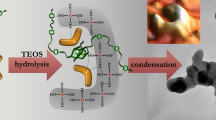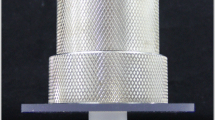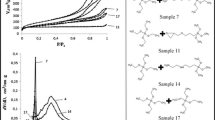Abstract
Ionic liquids (ILs) present many new opportunities for the field of sol–gel chemistry. When conducted in an IL medium, sol–gel chemistry can produce novel silica structures as well as hybrid materials known as ionogels, which feature ILs supported by a solid scaffold material. In this work, the influence of reactive formulation on the properties of silica-supported ionogels is reported. A simple, non-hydrolytic sol–gel reaction between tetramethoxysilane and formic acid is employed to create silica-supported ionogels that exhibit wide variations in silica content, gelation time, and mechanical character. The influence of formulation on gelation time is demonstrated, and it is shown that a range of formulations can be used to produce soft, mechanically compliant ionogels. Furthermore, either brittle or compliant ionogels can be realized via rapid- or slow-gelling formulations. It is observed that the speed of gelation influences the pore structure in the resultant silica scaffold, thereby enabling different mechanical characters to be achieved for ionogels containing equivalent silica mass fractions.
Graphical Abstract






Similar content being viewed by others
References
Dai S, Ju YH, Gao HJ et al (2000) Preparation of silica aerogel using ionic liquids as solvents. Chem Commun 3:243–244
Karout A, Pierre AC (2009) Porous texture of silica aerogels made with ionic liquids as gelation catalysts. J Sol-Gel Sci Technol 49:364–372
Migliorini MV, Donato RK, Benvegnú MA et al (2008) Imidazolium ionic liquids as bifunctional materials (morphology controller and pre-catalyst) for the preparation of xerogel silica’s. J Sol-Gel Sci Technol 48:272–276
Marimuthu T, Mohamad S, Alias Y (2014) Synthesis and characterization of new silica–titania mixed oxide in the presence of 1-butyl-3-methylimidazolium bis(trifluoromethylsulfonyl) imide by sol–gel technique. J Sol-Gel Sci Technol 70:104–110
Vioux A, Viau L, Volland S, Le Bideau J (2010) Use of ionic liquids in sol–gel; ionogels and applications. Comptes Rendus Chim 13:242–255
Le Bideau J, Viau L, Vioux A (2011) Ionogels, ionic liquid based hybrid materials. Chem Soc Rev 40:907–925
Sharp KG (1994) A two-component, non-aqueous route to silica gel. J Sol-Gel Sci Technol 2:35–41
Hench LL, West JK (1990) The sol–gel process. Chem Rev 90:33–72
Klein LC (1985) Sol–gel processing of silicates. Annu Rev Mater Sci 15:227–248
Mackenzie JD (1994) Structures and properties of ormosils. J Sol-Gel Sci Technol 2:81–86
Philipp G, Schmidt H (1984) New materials for contact lenses prepared from Si- and Ti-alkoxides by the sol–gel process. J Non-Cryst Solids 63:283–292
Vioux A (1997) Nonhydrolytic sol–gel routes to oxides. Chem Mater 9:2292–2299
Hench LL, Ulrich DR (1984) Ultrastructure processing of ceramics, glasses, and composites. Wiley, New York
Mackenzie JD, Ulrich DR (1988) Ultrastructure processing of advanced ceramics. Wiley, New York
Zarzycki J (1997) Past and present of sol–gel science and technology. J Sol-Gel Sci Technol 8:17–22
Horowitz AI, Panzer MJ (2012) High-performance, mechanically compliant silica-based ionogels for electrical energy storage applications. J Mater Chem 22:16534–16539
Néouze M-A, Bideau JL, Gaveau P et al (2006) Ionogels, new materials arising from the confinement of ionic liquids within silica-derived networks. Chem Mater 18:3931–3936
Néouze M-A, Le Bideau J, Vioux A (2005) Versatile heat resistant solid electrolytes with performances of liquid electrolytes. Prog Solid State Chem 33:217–222
Néouze M-A, Bideau JL, Leroux F, Vioux A (2005) A route to heat resistant solid membranes with performances of liquid electrolytes. Chem Commun 41:1082–1084
Martinelli A (2014) Effects of a protic ionic liquid on the reaction pathway during non-aqueous sol–gel synthesis of silica: a Raman spectroscopic investigation. Int J Mol Sci 15:6488–6503
Buckley AM, Greenblatt M (1994) The sol–gel preparation of silica gels. J Chem Educ 71:599
Ren H, Zhang L, Shang C et al (2010) Synthesis of a low-density tantalum oxide tile-like aerogel monolithic. J Sol-Gel Sci Technol 53:307–311
Acknowledgments
This research was performed with financial support from the National Science Foundation (award no. ECCS-1201935) and the US Army Natick Soldier Research, Development and Engineering Center. The authors thank Dr. Anna Osherov for assistance with the SEM images, which were obtained at the Center for Nanoscale Systems (CNS), a member of the National Nanotechnology Infrastructure Network (NNIN), which is supported by the National Science Foundation under NSF award no. ECS-0335765. CNS is part of Harvard University.
Author information
Authors and Affiliations
Corresponding author
Rights and permissions
About this article
Cite this article
Horowitz, A.I., Westerman, K. & Panzer, M.J. Formulation influence on the sol–gel formation of silica-supported ionogels. J Sol-Gel Sci Technol 78, 34–39 (2016). https://doi.org/10.1007/s10971-015-3918-7
Received:
Accepted:
Published:
Issue Date:
DOI: https://doi.org/10.1007/s10971-015-3918-7




